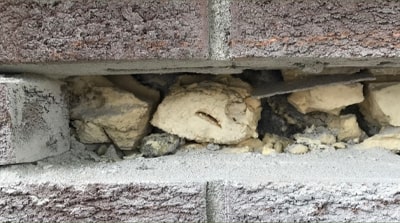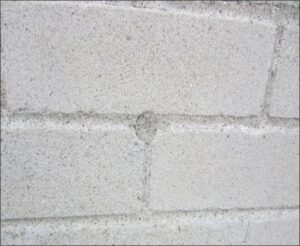Cost and turnaround time
UFFI air testing
Sampled by our expert
- Cost: ± $720
- Turnaround time: Report in ± 6 to 8 business days
UFFI material testing
If sampled by our expert (wall opening(s) by the client)
- Cost: ± $660
- Turnaround time: Report in ± 6 to 8 business days
If sampled by the client
- Cost: ± $420
- Turnaround time: Report in ± 4 to 5 business days
-

Questions? Appointment?
You can call us at 514 990-2063 or fill out the form below and we will contact you as soon as possible.
Test quality and credibility
The laboratory participates in the EMPAT program of the American Industrial Hygiene Association (AIHA). EMPAT is a performance evaluation program for environmental microbiology laboratories in accordance with the base requirements of organizations such as Health Canada and the Institut national de santé publique du Québec (INSPQ). Multitest as well as the laboratory are covered by errors and omissions liability insurance.
What is the problem?
The use of urea-formaldehyde foam insulation (UFFI, which is pronounced “you-fee”) began in the 1970s and was banned in the early 1980s due to its potential as an irritant and toxin. As UFFI has not been used since the 1980s, there should no longer be any toxic outgassing according to Health Canada and the Canada Mortgage and Housing Corporation (CMHC).
However, UFFI could deteriorate if it comes into contact with water or moisture. UFFI that is wet or disintegrating (e.g., because it is in poor condition or work is being performed) must be removed by a specialist and the source of the humidity eliminated, as the case may be.
Learn more about our uffi air testing and materials testing
What is UFFI?
Urea formaldehyde foam insulation (UFFI, which is pronounced “you-fee”) is a foamed-in-place insulation used to insulate buildings. UFFI insulation was very popular in the 1970s due to the high cost of oil heating following the oil crisis. The federal government subsidized this type of insulation for a time.
Health risks
Formaldehyde is an irritant that can cause burning sensations in the eyes, nose and throat. It can also be linked to respiratory problems, especially in asthmatic children.
Although formaldehyde is a recognized carcinogen, the concentrations normally found in homes are very unlikely to cause cancer.
Purpose of UFFI air testing
Testing is performed to determine whether indoor air is contaminated by formaldehyde emanations. Health Canada guidelines set short-term exposure at 0.1 ppm (parts per million) and 0.04 ppm for long-term exposure.
Purpose of UFFI materials testing
The purpose is to determine if the material being tested is UFFI. To conclude that the material is UFFI, we will check the material submitted for analysis for appearance, physical properties and potential presence of formaldehyde.
Additional information online
For more information about UFFI, please visit the following organizations’ websites:
Other sources of formaldehyde emissions
This gas is commonly found in residential indoor air. It can be emitted from building materials and furniture, particularly those made from particleboard products containing urea formaldehyde adhesives. It can also be emitted from sources such as tobacco smoke, potpourri, exhaust, fireplaces and wood stoves, and gas or oil appliances with faulty venting systems.
FAQ on UFFI testing
What does the uffi look like?
Is one air test enough?
It is recommended to take two to three air samples in a residential building in order to have them analyzed. The goal is to have a certain representativeness of the situation prevailing in the whole building, because if only one test is made, its result could be biased by a formaldehyde emanation not coming from the UFFI.
Indeed, the health risk related to UFFI being the emission of formaldehyde, it is important to know that this gas is commonly found in the indoor air of buildings. It can be emitted from building materials or furniture, particularly those made from particleboard products containing urea formaldehyde adhesives. It can also be emitted from sources such as tobacco smoke, potpourri, exhaust, fireplaces and wood stoves, and gas or oil appliances with faulty venting systems.
How do i know if my home has been insulated with UFFI?
The best known visual clue is the presence of finishing points at more or less regular intervals in the mortar joints of exterior brick walls (see photo below). These finishing points seal the holes where the UFFI was injected to insulate the space between the exterior cladding (usually the brick walls) and the interior walls of the building.
Also, there may have been references to the house being insulated with UFFI in previous deeds of sale or sellers’ declarations.
Which is better: testing the air or the material?
For the air test, the results will confirm whether the building’s indoor air is safe according to applicable standards, but will not confirm whether the building has been insulated with UFFI. In addition, since formaldehyde can emanate from sources other than UFFI (see the “Learn More” section under ” OTHER SOURCES OF FORMALDEHYDE EMISSIONS” and the previous FAQ under “IS ONE AIR TEST ENOUGH?”), it is possible to have a problematic test result that is not due to UFFI (called a false positive result).
Where is UFFI found?
UFFI has been used primarily for insulating the exterior walls of buildings, between the exterior cladding (usually brick walls) and the interior walls. However, UFFI can also be found in other areas such as the interior of concrete blocks in the exterior walls of commercial buildings or other cavities in a building that need to be insulated.
Is UFFI still in use?
UFFI was banned in Canada in December 1980 under the Hazardous Products Act. Notwithstanding the above, there are still many buildings insulated with UFFI since owners have never been required to remove this material, which, in most cases, no longer poses a significant risk of formaldehyde release since it was installed a long time ago (except if the UFFI comes in contact with moisture or if work in performed on it).
Some testimonials from our clients
“I wouldn’t have enough words to tell you what a great experience doing business with a gang who have fun with the customer and are very attentive. Fast and unparalleled service without complications. They return the calls to you and explain how they do it and you don’t talk to a machine; this is greatly appreciated. Well done to your team and keep up the good service to your customers, this is the recipe for success. You can count on me to do propaganda for your business, well done!”
Daniel Therrien, Google review, Greater Montréal
“Service worthy of note, courteous, prompt and simply genuine. My sincere congratulations to the entire team and good continued success!”
George Mardik, real estate broker │ Royal LePage Altitude │Google review, Greater Montréal
“I highly recommend Multitest. They took the time to give me good advice as I dealt with a delicate situation. I felt supported and 100% confident with this team. Rigor, efficiency in communications, respect for the estimate. A great experience.”
Daphné Caron, Google review, Greater Montréal
“Many thanks for your excellent service and the speed of your results. I regularly refer Multitest to my clients and this file confirms once again why I recommend you.”
Stéphane Dufour, building inspector │ L’inspecteur Urbain – building consulting services
“I must congratulate you on the quality of your work because we don’t see this too often these days.”
Jean Depatie, Saint-Bruno-de-Montarville
Main areas served by our UFFI air testing experts
North Shore of Montreal
We serve the North Shore of Montreal, including Laval, Mascouche, Terrebonne, Mirabel, Saint-Jérôme, Le Gardeur, Deux-Montagnes, Saint-Eustache, Pointe-Calumet, Saint-Joseph-du-Lac, Sainte-Marthe-sur-le-Lac, Blainville, Boisbriand, Bois-des-Filion, Lorraine, Rosemère, Sainte-Anne-des-Plaines, Sainte-Thérèse, Charlemagne, L’Assomption, Repentigny, Saint-Sulpice and L’Épiphanie.
City of Montreal
We serve the greater city of Montreal, including the following boroughs: Ahuntsic-Cartierville, Anjou, Côte-des-Neiges–Notre-Dame-de-Grâce, Lachine, LaSalle, Le Plateau-Mont-Royal, Le Sud-Ouest, L’Île-Bizard–Sainte-Geneviève, Mercier–Hochelaga-Maisonneuve, Montréal-Nord, Outremont, Pierrefonds-Roxboro, Rivière-des-Prairies–Pointe-aux-Trembles, Rosemont–La Petite-Patrie, Saint-Laurent, Saint-Léonard, Verdun, Ville-Marie and Villeray–Saint-Michel–Parc-Extension.
South Shore of Montreal
We serve a large portion of Montérégie, including Longueuil, Greenfield Park, Saint-Hubert, Brossard, Belœil, Boucherville, Candiac, Carignan, Chambly, Châteauguay, Delson, La Prairie, McMasterville, Mont-Saint-Hilaire, Otterburn Park, Saint-Basile-le-Grand, Saint-Bruno-de-Montarville, Sainte-Catherine, Saint-Constant, Saint-Isidore, Sainte-Julie, Saint-Lambert, Saint-Philippe, Saint-Jean-sur-Richelieu and Varennes.



